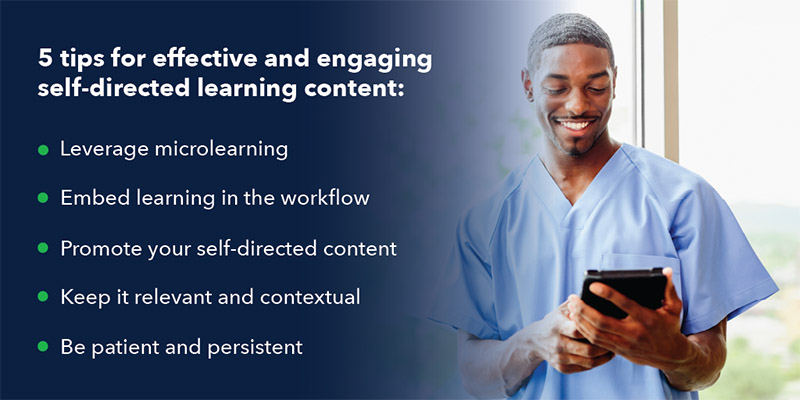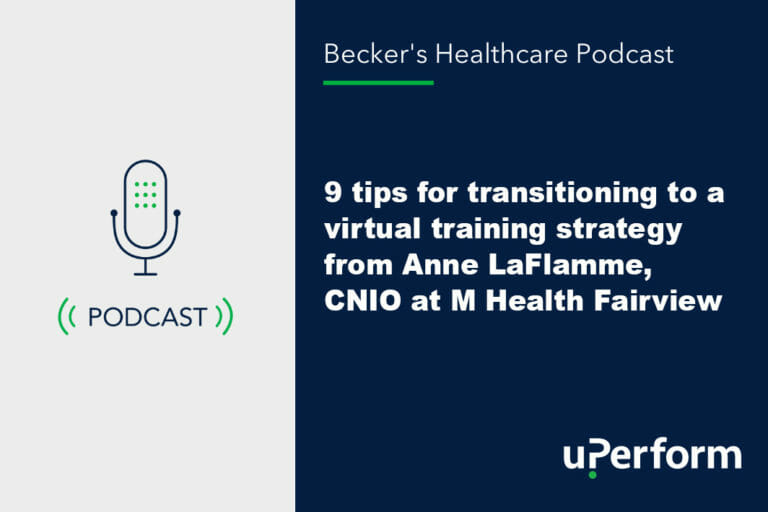Self-directed learning is becoming an increasingly common way to deliver training and support materials to healthcare workers. It’s a low cost, time-saving solution proven to help drive key metrics like EHR satisfaction and proficiency.
But as health systems move away from mandatory classroom training, some struggle to engage clinicians with learning content. In addition, education teams struggle to keep clinicians informed of upcoming changes. This can leave users feeling frustrated with the EHR and the lack of support from their organization.
Nothing is worse than putting time and work into training content change updates only for users to find it ineffective or not engage with it at all. But low engagement doesn’t mean clinicians don’t want training or don’t think it’s useful.
In fact, 54% of clinicians expressed a desire for more training in a 2023 KLAS Research survey. It’s not that clinicians don’t want more training; they just don’t want training that wastes their time.
uPerform enables health systems to deliver self-directed learning opportunities that clinicians can access directly in their EHR workflow. Training content is short, consumable and tailored to the user’s role in the system. It saves the organization and clinicians time and ensures that content is relevant and easy to access, driving engagement.
Based on industry-leading data and client success, we’ve put together some best practices for creating and communicating effective self-directed learning content that clinicians will want to engage with.
Why should organizations offer self-directed learning?
Offering self-directed learning is a great way to save your software users time and improve proficiency. A recent study by KLAS Research found that for every hour spent on self-directed learning, clinicians save more time in the EHR than they do with traditional training methods. The study also found that effective self-directed eLearning correlates with lower burnout and higher trust in IT leaders.
Training teams can also reclaim time and operate more efficiently by reducing time spent in instructor-led training. This enables training teams to deliver even more value to users by scaling learning and support resources, offering one-on-one training or providing more opportunities for EHR personalization.
5 Tips for driving engagement with effective self-directed learning
Health IT training can only be as effective as it is engaging. Yet, many health systems struggle to get clinicians engaged with their IT training experience. Clinicians may be reluctant to engage with training for several reasons. They might feel they are too busy, training isn’t effective, or they are proficient with their software tools.
However, KLAS Research data consistently shows that 3-5 hours of yearly training improves EHR satisfaction.
These 5 tips can help ensure your self-directed content is effective and gets the engagement it deserves:
1. Leverage microlearning wherever possible
Attentions spans are limited, and clinicians’ time even more so. When possible, keep learning materials short so clinicians can quickly access the information they need.
During this AMIA panel discussion, Dr. CT Lin, CMIO of UCHealth, emphasizes TikTok’s ability to engage audiences and quickly and effectively convey information. He used to create long videos loaded with detailed information to send to his clinical team. Now, he focuses on one topic and keeps his content short and digestible.
2. Keep it relevant and contextual
Too often, traditional training methods lack context and relevancy. Instructor-led training often groups multiple roles into one training session. However, KLAS Research data suggests training is more effective when it is workflow specific. uPerform enables organizations to provide role-based training content that is relevant and specific to each user’s workflow.
3. Embed learning in the workflow
Embedding self-directed learning materials in the workflow can be a great way to drive engagement. uPerform allows training teams to embed links to learning content directly in software applications, including Epic. If users get stuck on a certain workflow, they can quickly find the help they need to complete their current task.
uPerform clients report significant increases in engagement with training materials after embedding learning content into the EHR. In August 2023, Gundersen Health System saw over 5,200 content hits from launch points within Epic. This embedded help accounted for approximately one third of total engagement with learning content.
This increased engagement has also shown to increase adoption with new EHR workflows. M Health Fairview introduced a new eConsent navigator, they embedded microlearning content directly in the workflow as part of their virtual Epic training strategy.. Adoption of the new tool increased from just 7% to 87% after embedding the learning content.
4. Promote your self-directed content
Embedded content is good for engaging clinicians, but it shouldn’t be the only way to connect them to support content. While Gundersen has seen improved engagement thanks to embedded content, they still drive the most engagement from direct promotion. This includes placing direct links to content in emails, newsletters and other communications.
5. Be patient and persistent
Community Health Network has had resounding success driving engagement with content hosted in uPerform. Nearly 90% of its clinicians are utilizing their learning library.
We spoke with Jennifer Guenin, who is the IT Training Manager at CHN. She shared with us how they have successfully generated a high level of interest in their learning materials. Her advice? Be patient and persistent.
If you’re struggling to engage users with training, don’t expect change to happen overnight. It takes time for users to adopt new avenues for training and support. Be persistent in delivering and communicating quality content and user engagement will follow.
Related Articles
Deliver effective and engaging self-directed learning with uPerform
uPerform is a just-in-time learning and support platform that enables training teams to create and deliver role-based training directly in the workflow. uPerform clients report increased EHR satisfaction, increased content engagement and workflow adoption, improved scalability, and more.
Want to learn how uPerform can enable your organization to support clinicians with self-directed learning while they work? Contact us today to schedule a demo.






